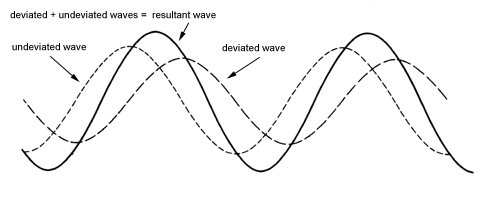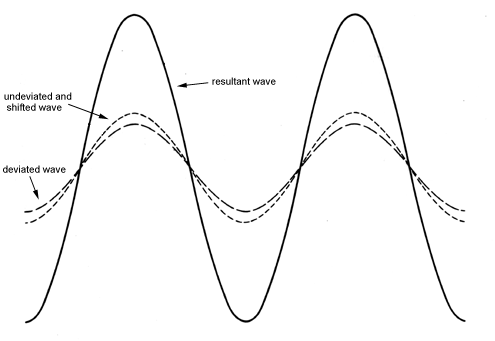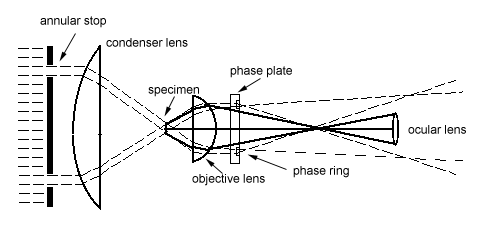 (Redrawn
from Gray)*
(Redrawn
from Gray)*
 (Redrawn
from Gray)*
(Redrawn
from Gray)*
Notice that the deviated wave is no longer parallel to the undeviated one and it has also become slightly diminished in amplitude. it is also retarded by about one quarter of a wavelength What the eye actually sees, however, is the resultant wave which comes about from the two waves being superimposed upon each other. Therefore a particle seen in brightfield would be slightly brighter than the background.
If the resultant wave is what the eye actually sees, then it should be obvious that if one were able to superimpose the deviated and undeviated waves, then the resultant wave would be almost doubled in amplitude. This is shown in the following diagram.
 (Redrawn from Gray)*
(Redrawn from Gray)*
Since brightness is proportional to the square of the amplitude, the object in this case would be almost four times as bright as the background. Also, if the one of the waves could be shifted one half wavelength relative to the other, the crest of one would correspond to the peak of the other, the object would be four times darker than the background. The latter situation is what we normally have in dark phase optics.
How is this accomplished in the microscope. The image below shows the setup of the dark phase optical path.
 (Redrawn
from Gray)*
(Redrawn
from Gray)*
By the use of a annular stop in the condenser and a phase plate within an objective lens aligned with the annular stop, a light beam can be split and each of the separated beams will pass through the same transparent medium. The light passes through the annular stop and forms a cone of light which comes to its vertex at the focal point of the specimen. Any background light which is not deviated by the specimen goes through the phase ring in the phase plate and is advanced about a quarter of a wavelength. Deviated light passing through the specimen is retarded by about a quarter of a wavelength and passes through the phase plate without going through the ring. When the beams are recombined further along the light path, the differences in the phase of the deviated and undeviated light beams become additive and subtractive. The resultant wave is sum of the two waves which have their crests and troughs opposite each other and is four times darker than the background. Therefore, the specimen appears four times darker than the background. The net result is that features of the object are either lighter or darker than the surrounding field.
Dark phase is the most common optical method used for viewing living cells. All of the inverted tissue culture microscopes employ it for quick examination of cells in tissue culture. Tissue culture microscopes should be cleaned periodically and their phase rings adjusted in order to obtain the best possible images of cells.
*Diagrams redrawn from Gray, P. 1964. Handbook of Basic Microtechnique. McGraw-Hill: New York.
|
|